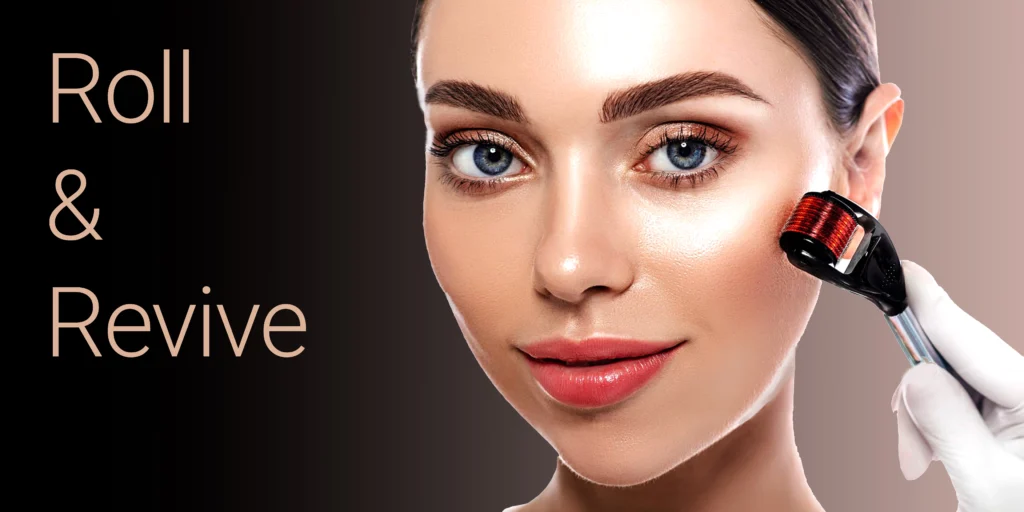Derma Roller: A Revolutionary Approach to Skin Care

Derma roller has gained significant popularity as a revolutionary approach to skincare. It is a new methodology for treating multiple skin issues, especially acne scars, inflammation, wrinkles, hair loss, and facial rejuvenation. You might ponder, “How on earth is embedding many little needles into your skin relaxing? It sounds surprising, yet micro-needling has a lot of advantages. This article aims to provide comprehensive information about derma rollers and their use for transdermal medication delivery.
Microneedling with a derma roller is a simple and cost-effective technique. Patients will tolerate this method and can be performed in a dermatologist’s clinic. During the procedure, the dermatologist meticulously works on the anesthetized area in horizontal, vertical, and diagonal directions. The protected technique typically takes around 15 to 20 minutes, depending on the size of the treatment area.
What is a Derma Roller?
As the name indicates, a derma roller has a roller on one end and a handle on the other. It is a microneedling instrument with a cylindrical head.
This skin care device comprises needles of differing lengths and thicknesses for making miniature wounds on the skin. When rolled over the skin, it creates tiny punctures or pricks on the surface. These micro-injuries stimulate the skin’s natural healing process and prompt collagen renovation. This clinical and cosmetic procedure is either done with a radio frequency machine or manually.
How does it function?
When the derma roller is rolled over the skin, it creates tiny pricks, inducing a controlled microscopic injury that leads to superficial bleeding. It does not cause damage to the external layer of skin. This triggers the wound-mending reaction of the body, and the skin stimulates collagen production. Collagen is a vital protein that helps maintain skin elasticity and firmness, and its increased production can improve the overall texture and appearance of the skin. This process enhances the skin’s texture and appearance.
For optimal results, the injury must be precise. The point should neither be too deep nor too superficial. This controlled injury encourages collagen formation and improves skin texture over time.
Uses of a Derma Roller
Dermarolling was initially used by dermatologists as an approach to boosting collagen production for treating facial scars and skin restoration. Presently, it is utilized as a method for delivering therapeutic drugs through the skin. Moreover, it has acquired fame as a home treatment to combat the appearance of scars and aging, reduce pore size and loss of skin firmness, and improve the appearance of stretch marks.
Derma roller for hair loss
Derma rolling could be the answer to helping you regrow thicker, longer, and healthier hair. It is good for anyone suffering from hair loss, hairline bold spots, thinning hair, alopecia areata, hair shedding, etc. Derma rolling creates micro-incisions in your scalp, which then stimulate collagen production, encourage blood flow, and increase growth factors in the hair follicle, making your hair grow thicker and stronger.
How to use a derma roller at home?
Home-use derma rollers are now available in the market. They can be used for transdermal delivery of skincare products up to twice a week. If utilizing a derma roller at home, an individual ought to follow the steps described here:
Step 1: After removing the derma roller from its holder, sterilize it with an alcohol solution.
Step 2: Clean up your face or scalp utilizing a delicate pH-adjusted cleanser or saline wash.
Step 3: Apply desensitizing cream, if necessary. You might need a numbing cream if your pain tolerance level is low. Adhere to the guidelines provided by the product manufacturer.
Step 4: Start derma rolling. The procedure is vital. Split your face or scalp into sections. Roll the tool over each segment in vertical and slanting directions. Depending on your skin tolerance, roll in one direction, then lift the roller. Adjust the tool after you roll in the same place several times and repeat. Do not roll diagonally, as this could create an uneven allocation pattern.
Step 5: Wash the skin with saline after the skin has reddened.
Step 6: After each use, it is essential to sanitize the rollers and let them dry thoroughly.
Step 7: Keep the roller inside the storage case after it has dried.
Practices for best derma rolling results
Attempting the following tips might assist with improved derma-rolling results:
1. Follow a basic skincare routine post-rolling.
2. Target hydrating healing. Saturate the skin with moisturizers, sheet masks, or serums with hyaluronic acid and niacinamide.
3. If you encounter any pain, apply ice packs.
4. To boost collagen production, take vitamin A and C supplements a month before the treatment.
5. Avoid exposure to the sun post-treatment, as it can cause tanning and pigmentation.
6. The therapy heightens the sensitivity of the skin, so do not skip the SPF.
7. Avoid the region around the eyes.
8. Soak the skin with vitamin C (ascorbic acid) a couple of days before a microneedling session, as its low pH might irritate your skin after the rolling therapy.
9. After the treatment, avoid chemical exfoliants like salicylic acid, benzoyl peroxide, etc.
10. Never share the tool with someone else.
Considerations when selecting a derma roller
Quality and Safety: Dermarolling involves needles that pierce the skin, so using well-made equipment is crucial to avoid health risks.
Trusted Retailers: Whether online or in-store, ensure you purchase your derma roller from a reputable retailer.
Professional vs. Home Use: Dermatologists use various medical derma rollers with different needle lengths for specific treatments. These professional devices are not available to the public and can be dangerous at home.
Home Care Dermarollers: For home use, select dermarollers with a needle length of less than 0.15 millimeters to ensure safety and effectiveness.
Alternative Treatments: Consider similar treatments like derma stamps, derma pens, and dermafracs as alternatives to derma rollers.
Potential side effects consideration
When done correctly, side effects are rare. However, improper technique or product use can lead to serious complications. Careless derma rolling “could potentially cause permanent scarring and darkening of the skin. Individuals with eczema, active acne or warts, psoriasis, or a history of blood clots should consult a healthcare provider or avoid derma rolling altogether. I
If you are using retinol or have sunburn, proceed with caution. Experts recommend discontinuing retinol use five days before derma rolling to prevent adverse reactions. For sunburn or inflammation, it is safe to use a derma roller as long as you avoid the affected areas.
When will you see the results?
The more you continue rolling, the more likely you are to see results. If you are attempting micro-needling to improve signs of aging or scarring, it might take a long time before you see noticeable changes. 6 to 12 weeks is the minimum standard time to see a difference.
How frequently should you repeat the process?
It depends on how your skin responds to the needles. Begin once every week to observe how your skin responds. If everything is going great, you can increase the repetition to two or three times a week. Ensure you’re not going over the 2-minute cutoff each time.
Stainless Steel vs. Titanium Dermarollers
Dermarollers are available with either stainless steel or titanium needles. Titanium needles are more durable because titanium is a stronger alloy, which means the needles last longer and retain their sharpness. On the other hand, stainless steel is naturally more sterile and sharper initially, though it dulls more quickly. This is why medical professionals, tattoo artists, and acupuncturists prefer stainless steel. Ultimately, both types of needles will perform the same function effectively.
20 Derma Roller Q&A.
1. Can I use the same derma roller on the scalp and face?
It’s best to have separate derma rollers for your scalp and face. The scalp has tougher skin and more impurities from daily pollution, while the skin on your face is more sensitive and should be protected from dirt and microbes.
2- Does Dermaroller work on the scalp?
A derma roller can stimulate cell turnover and improve scalp circulation, creating a healthier environment for hair growth. Longer needles (over 0.5mm) are more effective for this purpose, but they also come with a higher risk of injury.
3- Which is better, 0.5 or 1mm derma roller?
A 1.0 mm derma roller is versatile and can penetrate scar tissue or hair to reach the scalp. It’s longer than a 0.5mm roller, making it suitable for thin scar tissue like acne scars and promoting collagen induction.
4- Is a 1.5 mm derma roller safe for hair?
A 1.5-mm derma roller effectively promotes hair growth; however, most available derma rollers have 0.25-0.5-mm needles. Consult a dermatologist to find the best needle length for your needs.
5- What are the side effects of a derma roller?
Using a derma roller can cause mild to moderate skin irritation, including redness, itching, and inflammation, typically lasting a few hours to a day. There’s an increased risk of infection if the roller isn’t properly sterilized or used on infected or broken skin.
6- Can I use a derma roller every day?
No, it’s not recommended to use the tool daily. Start with once a week, and if your skin can handle it, increase to twice a week. Daily use is not advised.
7- Is derma roller permanent for hair growth?
It supports natural hair regrowth and healing but can’t reverse hair loss, even when combined with drugs like Minoxidil and Finasteride.
8- How many minutes should I derma roll my scalp?
A 5-10 minute session provides effective scalp coverage without overstimulating any particular area.
9- Can I apply oil after using a derma roller?
Yes, applying oils or minoxidil after derma rolling is fine. This helps your skin absorb around 80% of the nutrients in the oil.
10- Can I use the same derma roller for the face and hair?
No, using the same instrument for the face and hair increases the risk of infection and scarring on the face.
11- Is A Dermarolling Painful?
With proper numbing preparations and appropriate aftercare, derma rolling should not be intolerably painful. You may feel mild to moderate discomfort as the needles stimulate collagen production.
12- What size derma roller is most effective?
The best needle size depends on your goals. Generally, 0.25 mm to 1.0 mm needles are effective.
13- How does derma roll a hairline?
To use a derma roller for hair regrowth, roll it across the scalp in multiple directions: horizontally, vertically, and diagonally. Apply firm pressure without causing pain, and avoid rolling over the same area too many times.
14- Who should not use this instrument for hair?
This instrument can damage hair at the root if done too deeply, potentially cutting the hair off. Avoid if there’s a risk of harming the hair more than helping it.
15- When to wash hair after microneedling?
Wash your hair for at least 24 hours after derma rolling. Use a mild shampoo and avoid harsh chemicals or fragrances.
16- When should I stop using it?
They are most effective with short-term treatments every four to six weeks for three to six months. Afterward, use it once or twice a month to maintain results.
17- How many months should I use it for hair?
Use it once every three weeks. The scalp is tender, and this frequency allows for proper microneedling without overdoing it.
18- What size roller is suitable for the face?
For the face, neck, or areas with thinner skin, a 0.5 mm derma roller is suitable. For areas like the stomach, back, or thighs, use longer needles (1.0 or 1.5 mm) for better results.
19- What size roller is most effective?
The best needle size depends on your goals. Generally, 0.25 mm to 1.0 mm needles are effective.
20- Is titanium or stainless steel better for derma rolling?
Titanium is generally better for derma rolling due to its durability and resistance to corrosion.
Conclusion
Derma rolling or collagen induction therapy offers a revolutionary approach to skincare and hair regrowth, with potential benefits including improved skin texture, reduced acne scars, and enhanced hair growth. However, it’s essential to use them correctly and choose the appropriate needle length to avoid complications.
Disclaimer: Always consult with a healthcare professional before starting any new skincare treatment. Improper use of derma rollers can lead to adverse effects, including permanent scarring and skin discoloration. Individuals with certain skin conditions should avoid derma rolling or seek professional guidance.























